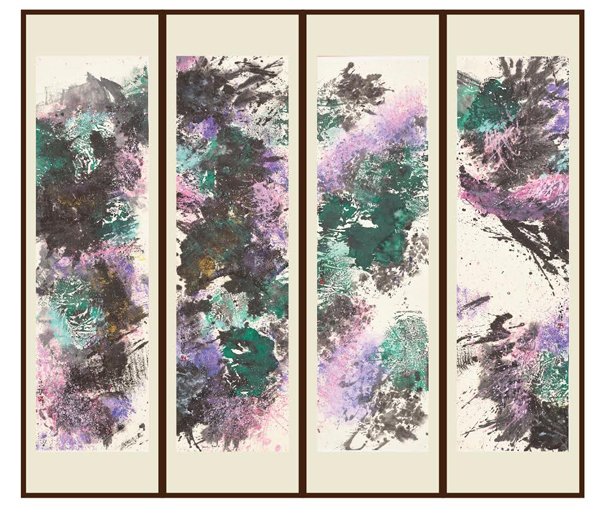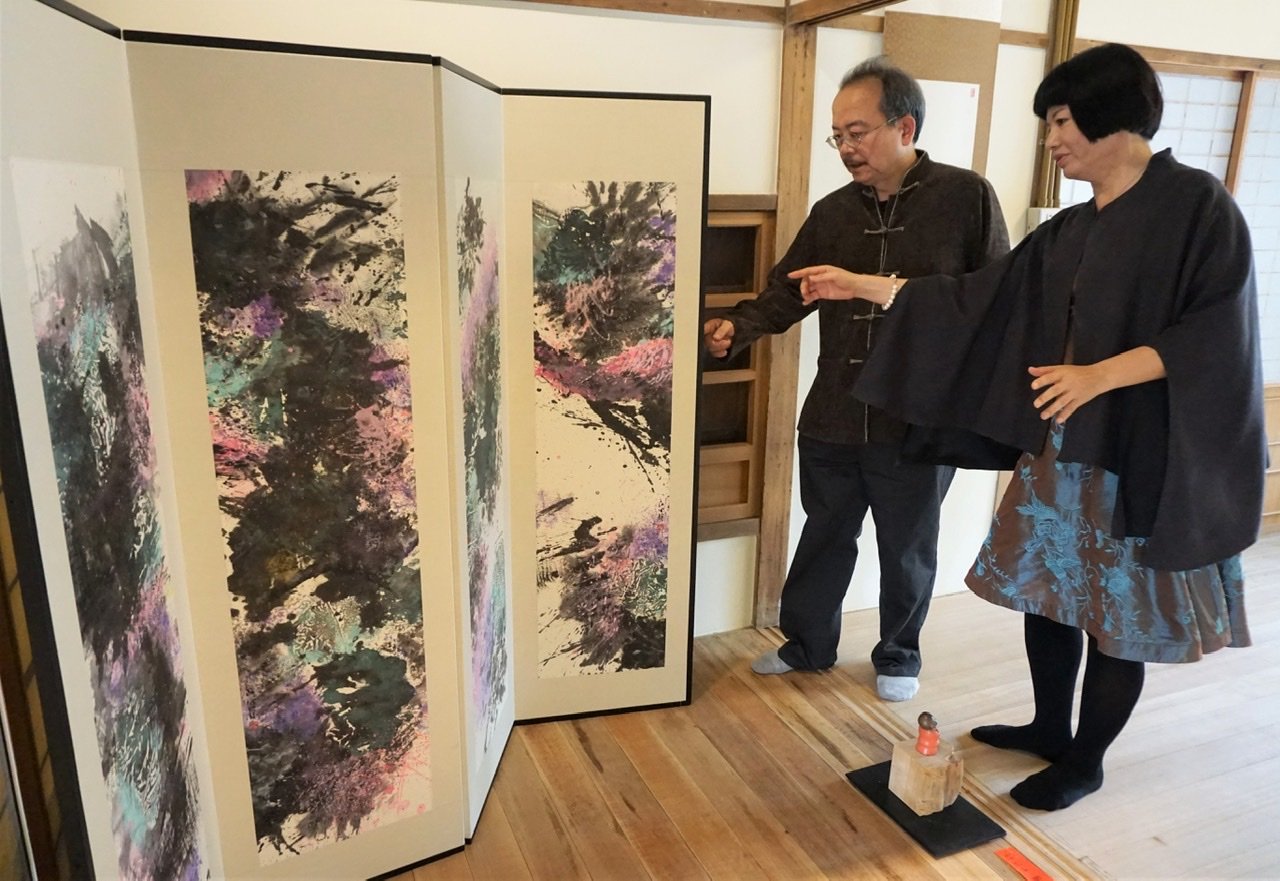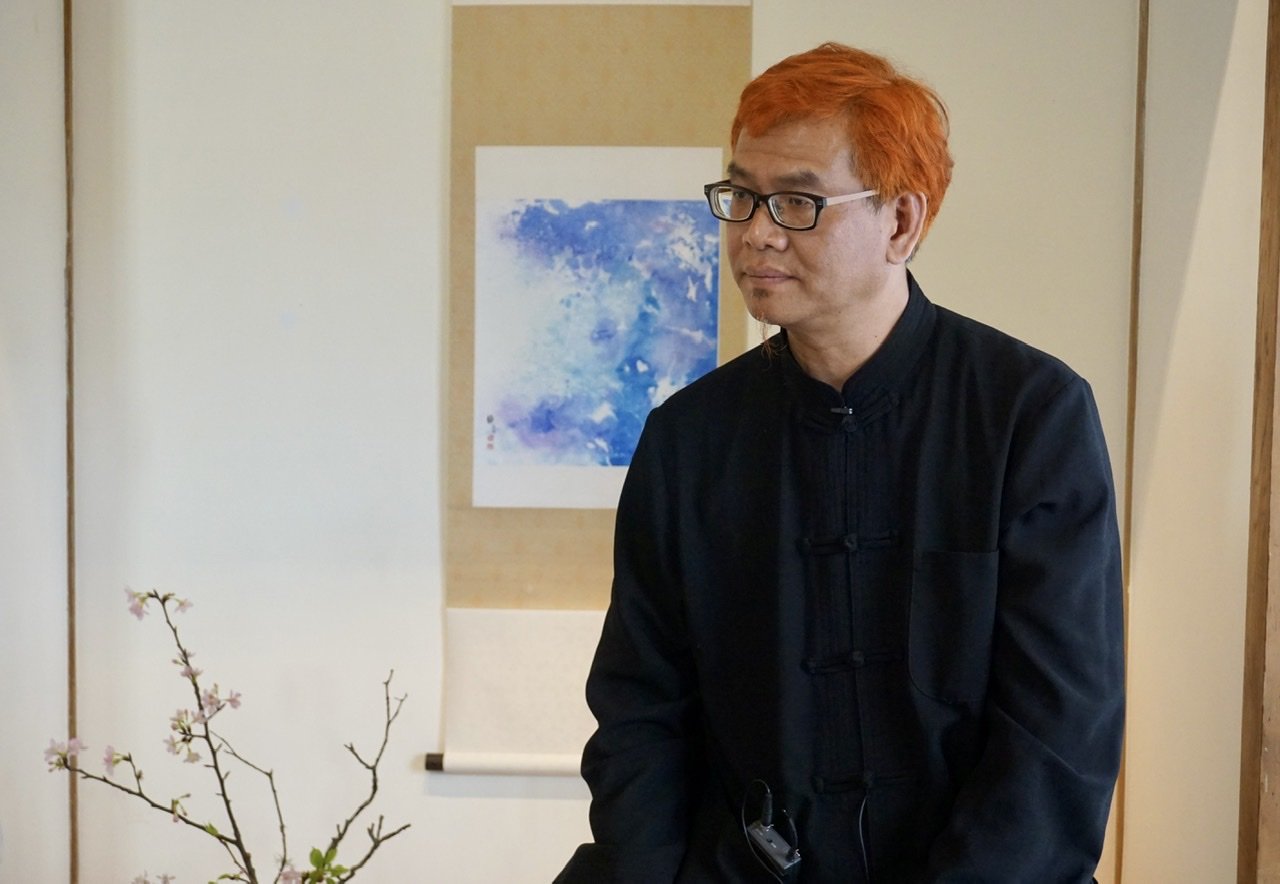創作自述
《花漾年華》
一山啁啾
花的春情 蕩漾
新綠搶頭香
演奏岩之靜寂交響樂
2015 - 江心靜 - 道隱系列-花漾年華四幅 - 122x 33x 4 cm-水墨設色紙本
傳統花鳥畫的創作哲學是「一花一世界,一葉一如來」,透過描繪大自然的生機呈現藝術家空靈的精神世界,心靈與自然合一,既超越自然又貼近自然。
當代花鳥畫療癒身心
二十一世紀,大多數人生活在遠離自然的都市中,感受大自然的能力逐漸退化。身為當代水墨藝術家,嘗試以半抽象的水墨技法,去除花鳥畫的裝飾性,在手工宣紙,揮灑充滿想像力的純淨世界,留白,紓解現代人受到過量影音刺激的感官疲乏。張開眼睛,看春花含笑,打開耳朵,聽蟲鳴鳥叫,清通鼻孔,呼吸新鮮空氣,甚至,喝一杯現打蔬果汁,通體舒暢,回歸大自然,一切壓力消弭於無形。
美,具有強大的療癒能量,就像海水、陽光、空氣、森林,與大自然保持和諧,生命充滿喜樂。
茶人莊麗香女史 與 藝術家 江心靜 / 2016 江心靜「花漾年華」創作展戶外茶席
經典小說醞釀的屏風美學
《花漾年華》四連幅是我用當代水墨的抽象語彙,表現臺灣春天茂盛的新綠,充滿生命力,山櫻花盛開。
當代水墨在形式上,我覺得是可以創新的,重點是用什麼方式都可以來呈現,像這四連幅有平面的想像空間,又有空間的立體感,不想照傳統加上畫框或是裱成掛軸,希望可以有不一樣的呈現。
一直很喜歡屏風,雖然在成長環境中沒有直接接觸過,但因閱讀結下不解之緣。床頭書《紅樓夢》集清代貴族生活美學之大成,不論是氣派大廳、文雅書齋和精巧寢室,處處有屏風的身影,有天,寧國府來了貴客,俊俏瀟灑的賈蓉為了充場面,特地向鳳姐借了一架玻璃炕屏,現在玻璃很普遍,在清朝卻是稀有貢品,可見高貴屏風代表身份地位,就像現在豪宅的義大利進口傢俱。
屏風最早用來擋風,到了清代,結合書畫、木雕、珐瑯、牙雕、蘇繡、剔紅各種鑲嵌工藝,精美絕倫,後來,在北京故宮、胡雪巖故居以及數不清的宅院見識過。
感謝法國藝術家 Alix(右二) 和 苡樂畫廊主人 陳靜紅(右一)蒞臨。
另一本百看不厭的小說《源氏物語》,年代更早,平安朝受唐文化影響,人們席地而坐,男女幽會都是隔著屏風談心,隨愛意滋長,推開屏風的阻礙,依偎在一起,屏風是禁忌愛情的象徵。唐屏風在日本流傳至今,屏風是移動的壁畫,木地板或榻榻米房間的視覺焦點。
谷崎潤一郎在《陰翳禮讚》書中描述在陰暗的建築,點燈欣賞日本金屏風的絕美:
「隨著步伐由正面移向側面,那以金箔為底紙的表面會悠然地炯炯發光。那絶不是一閃一閃的快速閃爍,而是如同巨人變換臉色般,驀然生威,必須長期養精蓄銳方能發亮。有時,那打光成梨皮狀的金箔,前一瞬間才反射著懶洋洋的光芒,但轉向側面時,突然會發現金光耀眼如火焚。」
突破萬難重現日式文人屏風
苦思如何把《花漾年華》四連幅用屏風呈現,在國美館看到鄉原古統百年前創作的「庭院」四通屏,鑲金片的邊框和背面的絹布精緻沉穩,模糊的畫面頓時清晰起來,與繁複的清屏風相比,更愛古樸的日式屏風。
從想像到真實,整整花了半年,原來在台灣,現在要做層層紙張包覆木骨架的日式屏風,比登天還難,艱辛曲折的過程考量到裱褙師傅希望保持低調的意願,就不詳述了。經過繁複的裱褙,當師傅把「花漾年華四通屏」豎立起來,多年藏在小說字裡行間的屏風,如燭火前看到的神秘金箔,穿越亙古的黑暗,擊中一心追求美的心,滿山遍野的春花,隨著曲折的屏風錯落,伸手可及,心中的感動難以言喻。
茶會掛軸讓藝術走進生活
除了屏風,這次展覽中有很多作品用「掛軸」呈現。起因是去年在京都上茶道課程,了解在日本一代茶聖千利休心中,茶會最重要的茶具就是「掛軸」,他認為掛軸選出來後,才能決定茶會主題,跟著選擇其他器具,掛軸等於是整個茶會的精神所在,讓我想到當代水墨用掛軸裱褙,可以和台灣流行的茶席結合,讓強調前衛創新的當代藝術進入生活。
2015 - 江心靜 - 道隱系列-空山花雨-2015- 48 x 22 cm-水墨設色紙本
林之助紀念館有童年回憶
「台灣膠彩畫之父」林之助 (1917~2008),其居住和創作長達六十年的畫室,為日治時期木造宿舍,經台中市政府核定為歷史建築,修復後成立「林之助紀念館」於2015年6月6日開幕,內部展出林之助畫作及使用物品,紀念館以推廣林之助藝術精神為核心,落實國民的文化參與權。
心靜1970年在台中出生,老家在中山路,父母經營「光明素食館」十多年,柳川這一帶充滿成長的記憶,此次展覽以屏風和掛軸方式呈現,配合日本花藝師設計的盆花,創造當代水墨藝術和日式建築空間對話,藉此展覽向林之助教授致敬。
台師大程代勒教授蒞臨指導 / 2016 江心靜「花漾年華」創作展
台師大莊連東教授蒞臨指導 / 2016 江心靜「花漾年華」創作展
藝術家江心靜(左)與策展人林存青(右)
《Spring Blooms》 2015/Literati ScreenFlowers in spring, chirping in the mountainsBlooming, budding in fresh greenness,Playing an orchestra of silence amongst the rocks.
Artist Essay
“Spring Blooms” is a four-part painting in which I used abstract painting methods to express the fresh thriving greenness and vitality during Taiwan’s spring as well as the omnipresent cherry blossoms in full bloom during this time.
Looking at the four parts of the painting, I cannot help but feel that it would be a shame to frame it as a four-part painting, and it'd also be a shame to hang them up on four hanging scrolls. I feel that the work calls for a different presentation. Then it occurred to me that I have had long-standing fondness for screens. Though screens have never played a substantial part in my life while I was growing up, but maybe my love for reading has brought me into contact with screens via books like The Tale of Genji, a depiction of everyday living situations during the Heian period in Japan. At that time, Japan was heavily influenced by the culture of the Tang Dynasty in China, thus during that time, screens were used as partitions or as wind shields, so one can say screens are basically "mobile paintings".
To create Japanese-styled screens from that period was no easy feat, and it took half a year and much trial and error. It was a process full of twists and turns! In the end, when the framing artist stood the screen up, the painting was brought to life, and we felt a sense of great elation. I knew then that we had found the best way to present the painting.
I feel that there can be innovation in contemporary ink wash paintings, meaning that you can present it in whatever method you desire. The reason I opted to use “hanging scrolls” as my method of presentation is because ‘hanging scrolls’ is a medium that is rich in history. For instance, Sen no Rikyū, the Saint of Tea in Japan, believes that the most important tea-ware in Japanese “Way of Tea” is the hanging scroll. Rikyū thinks that only after the hanging scroll is selected can the theme then be determined, followed by the selection of other tea wares. As such, one can say the hanging scroll is a spiritual symbol for the entire tea ceremony.In fact, my experience of the tea ceremony in Kyoto, Japan tells me that the creativity of art works can be integrated with the contemporary and fashionable tea mats, akin to identifying a method for the realization of incorporating art into daily life.













